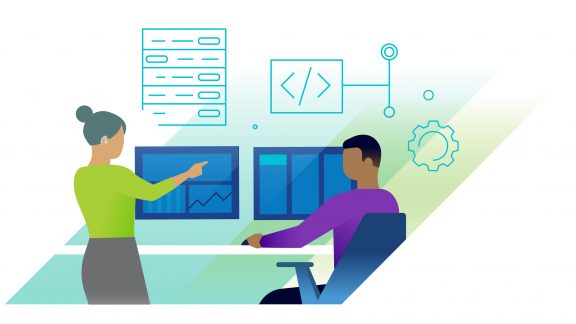A number of enterprise customers have established dedicated organizations to leverage VMware’s cloud technology. As these organizations reach increasing levels of cloud maturity, we are more and more often asked by our customers: “how is our organization going to be impacted by DevOps?“
Whilst there are many facets – and interpretations – to DevOps, I will highlight in this blog that many of the skills needed for DevOps are already inherent to a fully- functioning cloud organization. Broadly speaking, my view is that we are looking at evolution, not revolution.
First, let’s outline briefly what we understand by DevOps from a people/process/technology point of view:
 People: DevOps originated as an approach, even a philosophy that aims to break down organization silos, specifically the traditional gap between application developers and operations teams. This is why it is often said that DevOps is first of all, about people and culture. Application Developers are sometimes depicted as “agents of change” whilst the Operations team are seen as “guardians of stability” – teams with opposite objectives that can lead to well-documented inefficiencies.
People: DevOps originated as an approach, even a philosophy that aims to break down organization silos, specifically the traditional gap between application developers and operations teams. This is why it is often said that DevOps is first of all, about people and culture. Application Developers are sometimes depicted as “agents of change” whilst the Operations team are seen as “guardians of stability” – teams with opposite objectives that can lead to well-documented inefficiencies.- Process: From a methodology point of view, DevOps integrates principles such as “agile development”. Agile this provides the methodological underpinning for Continuous Delivery, an approach that relies on the frequent release of production-ready code. Whilst Agile development was originally about applications, DevOps extends the principle to infrastructure (leading to the idea of “agile infrastructure”).
- Technology: DevOps processes necessarily incorporate the use of development and automation technologies such as: source code control and management (e.g, Git); code review systems (e.g., Gerrit); configuration management (e.g., Puppet, Chef, Ansible, SaltStack); task execution and management (e.g., Jenkins); artifact and application release tooling (e.g., VMware vRealize Codestream); and others. In order to manage those tools as well as applications generated by them, DevOps also incorporates operations tooling such as provisioning and monitoring of the underlying infrastructure (e.g., vRealize Automation and vRealize Operations).
Features of a cloud organization adapted for VMware’s cloud technology, are described in detail in the white paper “Organizing for the Cloud” (link below):
https://www.vmware.com/files/pdf/services/VMware-Organizing-for-the-Cloud-Whitepaper.pdf
Here are, in my view, some key capabilities in the cloud organization as recommended by VMware:
1) The rise of developers’ reach.
As development departments mature beyond writing strictly application code, their reach spans broader knowledge bases. This includes writing code that performs end-to-end automation of application development, deployment and management: applications and infrastructure as code. Developers utilize the same skills traditionally relied on in application teams and apply them towards cloud services:
- Provisioning for example with VMware vRealize Automation.
- Automating network configuration with VMware NSX
- Automating monitoring and performance management (VMware vRealize Operations).
This shift in reach from Ops to Dev forms the the basis of ‘infrastructure-as-code’ – a now relatively standard cornerstone of DevOps.
2) Ability to work across silos
One of the defining capabilities of a cloud team – and a key skill required of all team members, is to be able to break the boundaries between silos:
- Technical silos: for example the customer-facing team (Tenant Operations, also known as IT Service Center) will define end-to-end cloud services across technical silos such as compute (servers), networks and storage. Service Owners and Service Architects will define the scope and remit of such services; Service Developers will put together the workflows and scripts to allow end users to provision those services automatically.
- Functional silos – merging “Design” and “Run”. Whilst traditional IT organizations tend to separate teams of architects/designers from operations team, the cloud development teams bring those skills together. Service Developers for example will build workflows that include not only the deployment of infrastructure, but automate its monitoring and configuration management at runtime. Service Owners are involved both in the definition of services but also act as point of contact in resolving incidents impacting those services. DevOps takes this trend to the next level by merging the “dev” and “ops” teams.
3) Increased alignment with the business
Whilst all IT organizations aim to align with the business, A model organization (as described in “Organizing for the Cloud”) aligns business lines with practical structures and roles. For example this model defines dedicated roles such as:
- Service Architects who translate business requirements into functional and technical architectures.
DevOps continues this trend towards business alignment: in a context where business is increasingly driven by revenue-generating applications, application development becomes integral to the lines of business.
In sum, a well-functioning cloud team will have established many of the positive traits needed for DevOps – a preference for rapid development over fire-fighting, for bridging silos across technologies and processes, and for close cooperation across business lines.
Going one step further DevOps pushes these traits to the extreme – preferring continually improving development and automation of application and infrastructure. For example a Devops team might leverage VMware’s Cloud Native Apps capabilities to build applications optimized to run on cloud from “day one” (for more details see https://www.vmware.com/cloudnative/technologies).
Take-away – practical ways to prepare your cloud team for DevOps;
- Encourage job rotation of key team members across technical skills and functions.
- Continuously expand your team’s knowledge and practice of cloud automation tools. This can include advanced training on tool such as vRealize Automation, vRealize Operations; as well as generic skills in analysis and design.
- Ensure that key tenant operations roles (i.e. customer facing roles) are in place and give them increasing exposure to application development and business lines.
- Develop an awareness of Agile approach for example by formal training and/or nominating ‘Champions’ in your team.
- Build up a skill base in Continuous delivery, for example leveraging training or a pilot with vRealize Codestream.
—-
Pierre Moncassin is an operations architect with the VMware Operations Transformation global practice and is based in the UK.





